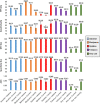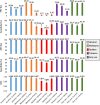Automated detection of substance use information from electronic health records for a pediatric population
- PMID: 34333636
- PMCID: PMC8449626
- DOI: 10.1093/jamia/ocab116
Automated detection of substance use information from electronic health records for a pediatric population
Abstract
Objective: Substance use screening in adolescence is unstandardized and often documented in clinical notes, rather than in structured electronic health records (EHRs). The objective of this study was to integrate logic rules with state-of-the-art natural language processing (NLP) and machine learning technologies to detect substance use information from both structured and unstructured EHR data.
Materials and methods: Pediatric patients (10-20 years of age) with any encounter between July 1, 2012, and October 31, 2017, were included (n = 3890 patients; 19 478 encounters). EHR data were extracted at each encounter, manually reviewed for substance use (alcohol, tobacco, marijuana, opiate, any use), and coded as lifetime use, current use, or family use. Logic rules mapped structured EHR indicators to screening results. A knowledge-based NLP system and a deep learning model detected substance use information from unstructured clinical narratives. System performance was evaluated using positive predictive value, sensitivity, negative predictive value, specificity, and area under the receiver-operating characteristic curve (AUC).
Results: The dataset included 17 235 structured indicators and 27 141 clinical narratives. Manual review of clinical narratives captured 94.0% of positive screening results, while structured EHR data captured 22.0%. Logic rules detected screening results from structured data with 1.0 and 0.99 for sensitivity and specificity, respectively. The knowledge-based system detected substance use information from clinical narratives with 0.86, 0.79, and 0.88 for AUC, sensitivity, and specificity, respectively. The deep learning model further improved detection capacity, achieving 0.88, 0.81, and 0.85 for AUC, sensitivity, and specificity, respectively. Finally, integrating predictions from structured and unstructured data achieved high detection capacity across all cases (0.96, 0.85, and 0.87 for AUC, sensitivity, and specificity, respectively).
Conclusions: It is feasible to detect substance use screening and results among pediatric patients using logic rules, NLP, and machine learning technologies.
Keywords: automated substance use detection; deep learning; electronic health records; natural language processing; pediatric population.
© The Author(s) 2021. Published by Oxford University Press on behalf of the American Medical Informatics Association.
Figures





References
-
- McGinnis JM, Foege WH.. Mortality and morbidity attributable to use of addictive substances in the United States. Proc Assoc Am Physicians 1999; 111 (2): 109–18. - PubMed
-
- National Institute on Drug Abuse. Cost of substance abuse. 2020. https://www.drugabuse.gov/drug-topics/trends-statistics/costs-substance-.... Accessed February, 19, 2021.
-
- Johnston L, Miech R, O'Malley P, Bachman J, Schulenberg J, Patrick M.. Monitoring the Future National Survey Results on Drug Use, 1975-2018: Overview Key Findings on Adolescent Drug Use. Ann Arbor, MI: Institute for Social Research, University of Michigan; 2019.
-
- Substance Abuse and Mental Health Services Administration. Key Substance Use and Mental Health Indicators in the United States: Results from the 2018 National Survey on Drug Use and Health (HHS Publication No. PEP19-5068, NSDUH Series H-54). Rockville, MD: Center for Behavioral Health Statistics and Quality, Substance Abuse and Mental Health Services Administration; 2019.

